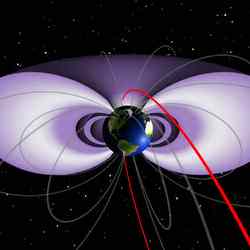
The Van Allen Belts pulsing from solar particles. Image credit: NASA/Tom Bridgman. Click to enlarge
A “safe zone” in the radiation belts surrounding Earth moves higher in altitude and latitude during peaks in solar activity, according to new research by a NASA-led team. The safe zone offers reduced radiation intensities to any potential spacecraft that must fly in the radiation belt region.
“This new research brings us closer to understanding how a section of the radiation belt disappears,” said Dr. Shing Fung of NASA’s Goddard Space Flight Center, Greenbelt, Md. Fung is lead author of a paper on this research appearing in the on-line version of Geophysical Research Letters February 22.
The team based its results on measurements of high-speed particles (electrons), which comprise the “Van Allen radiation belt”, from the National Oceanic and Atmospheric Administration’s series of polar-orbiting meteorological spacecraft during 1978 to 1999. As the spacecraft flew in their polar orbits, they detected fewer radiation belt particles at a certain latitude range, indicating safe zone passages by the spacecraft. The researchers compared the data taken during relatively low solar activity periods, called solar minimum, to data from peak solar activity periods, called solar maximum. They noticed a shift in the safe-zone location towards higher latitudes, and therefore altitudes, during solar maximum.
If the radiation belts were visible, they would resemble a pair of donuts around the Earth, one inside the other with the Earth in the “hole” of the innermost donut. The safe zone, called the “slot region”, would appear as a gap between the inner and outer donut. The belts are actually comprised of high-speed electrically charged particles (electrons and atomic nuclei) that are trapped in the Earth’s magnetic field.
The Earth’s magnetic field can be represented by lines of magnetic force emerging from the South Polar region, out into space and back into the North Polar region. Because radiation-belt particles are charged, their motions are guided by the magnetic lines of force. Trapped particles would bounce between the poles while spiraling around the field lines.
Very Low Frequency (VLF) radio waves and background gas (plasma) are also trapped in this region. Just like a prism that can bend a light beam, the plasma can bend the VLF wave propagation paths, causing the waves to flow along the Earth’s magnetic field. VLF waves clear the safe zone by interacting with the radiation belt particles, removing a little of their energy and changing their direction. This lowers the place above the polar regions where the particles bounce (called the mirror point). Eventually, the mirror point becomes so low that it is in the Earth’s atmosphere. When this happens, the trapped particles collide with atmospheric particles and are lost.
According to the team, the safe zone is created in a region where conditions are favorable for the VLF waves to kick the particles. Their research is the first indication that the location of this region can change with the solar activity cycle. The Sun goes through an 11-year cycle of activity, from maximum to minimum, and back again. During solar maximum, increased solar ultraviolet (UV) radiation heats the Earth’s upper atmosphere, the ionosphere, causing it to expand. This increases the density of the plasma trapped in Earth’s magnetic field.
Favorable conditions for the VLF wave-particle interaction depend on the specific combination of plasma density and magnetic field strength. Although plasma density generally decreases with altitude, expansion of the ionosphere during solar maximum makes the plasma denser at the safe zone’s solar-minimum altitude, and forces the favorable plasma density for the safe zone to migrate to a higher altitude. In addition, magnetic field strength also decreases with altitude. To find the favorable magnetic field strength for the safe zone at higher altitudes, one would have to migrate toward the poles (higher latitudes), where the magnetic field lines are more concentrated and thus stronger.
“This discovery helps narrow down the search for the primary wave-particle interaction region that creates the safe zone,” said Fung. “Although no known spacecraft uses the safe zone extensively now, our knowledge could help planning and operations of future missions that want to take advantage of the zone.”
According to the researchers, their discovery was enabled by a new data selection and retrieval tool developed by the team, called the Magnetospheric State Query System. The research was funded by NASA and the National Research Council. The team includes Fung, Dr. Xi Shao (National Research Council, Washington), and Dr. Lun C. Tan (QSS Group, Inc., Lanham, Md.).
Original Source: NASA News Release
